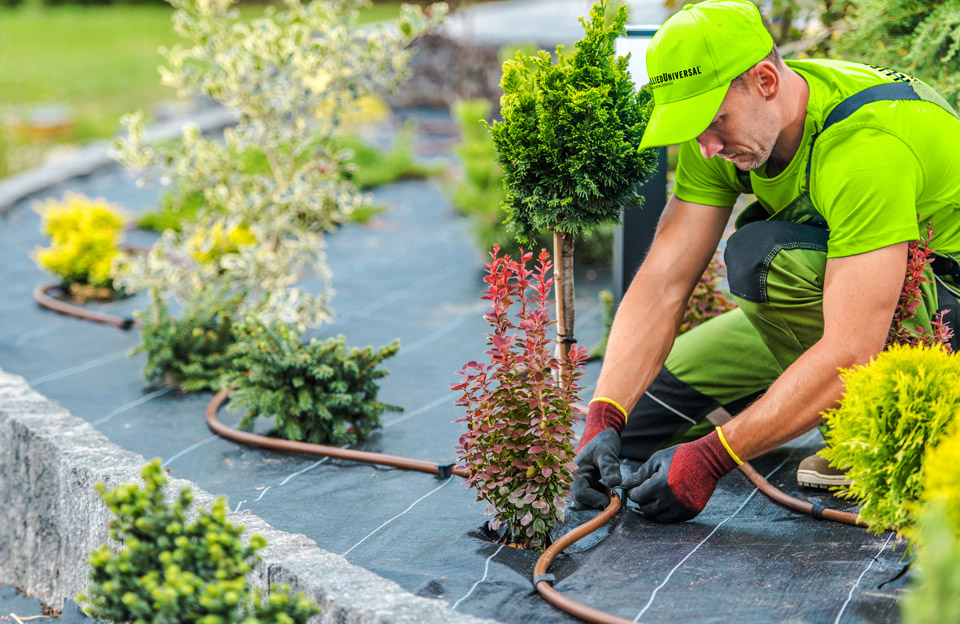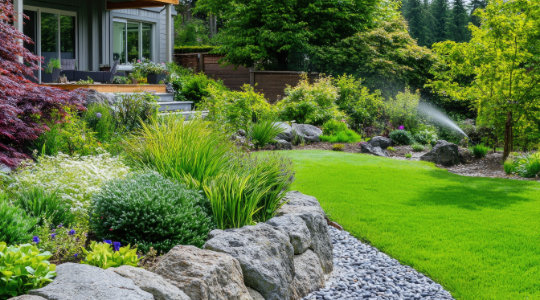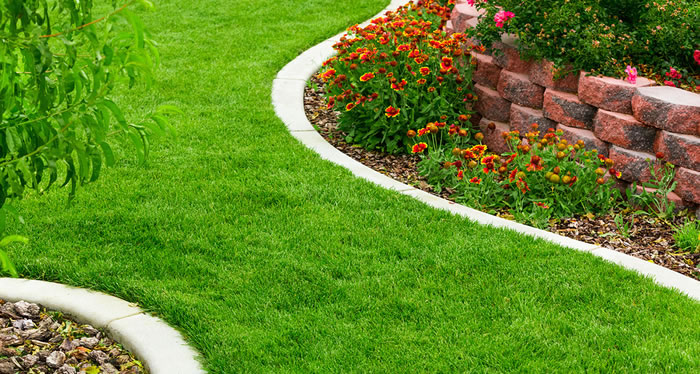Steps to design the perfect yard with landscaping services
Understanding the Comprehensive Range of Works in Professional Landscape Design Services
The considerable range of specialist landscape design services encompasses a range of basic aspects - landscaping. It includes landscape design principles, plant choice, and hardscaping functions. In addition, it attends to irrigation systems and maintenance strategies. Each aspect plays a critical role in creating useful and cosmetically pleasing outside spaces. Understanding just how these parts work with each other can reveal much about the art and scientific research of landscape design. However, the trip right into this intricate area is simply starting
Landscape Style Concepts
Efficient landscape style principles are vital for producing unified outside areas that boost both aesthetic appeal and performance (Learn More). These concepts guide the arrangement of components within the landscape, guaranteeing a cohesive aesthetic experience. Key elements consist of balance, which disperses visual weight uniformly; proportion, which connects the size of different elements to each other and the space; and unity, which develops a feeling of wholeness via constant styles and products

Plant Selection and Setup
In the domain name of specialist landscape design, plant choice and installment play an essential role in attaining a prospering garden. Highlighting native plant advantages, seasonal considerations, and the particular dirt and sunshine demands of each varieties guarantees a lasting and cosmetically pleasing landscape. Mindful planning in these locations not just improves biodiversity yet also advertises long-term eco-friendly health and wellness.
Native Plant Benefits
Why should property owners take into consideration native plants for their landscaping tasks? Indigenous plants offer many advantages that enhance both looks and environmental sustainability. They are well-adapted to regional climates, requiring much less water and maintenance contrasted to non-native types. This resilience minimizes the need for chemical fertilizers and pesticides, promoting a much healthier ecological community. Additionally, native plants supply habitat and food for regional wildlife, including pollinators, which can enhance biodiversity in suburbs. Their familiarity with regional dirt and weather condition problems likewise brings about far better growth prices and longevity. By choosing indigenous plants, property owners not only create visually enticing landscapes however additionally add to ecological preservation, making a favorable influence on their neighborhood setting. Subsequently, native plants represent a wise selection for landscape design projects.
Seasonal Plant Considerations
Homeowners that have actually welcomed indigenous plants in their landscape design can even more improve their outside spaces by considering seasonal plant choices. By incorporating plants that flourish in particular periods, they can create aesthetically appealing and vibrant landscapes throughout the year. Spring may introduce vivid blooms like tulips and daffodils, while summer season can display lush vegetation and vivid perennials. Autumn presents a combination of cozy tones with asters and goldenrods, while winter months can be accentuated with evergreens and ornamental turfs for texture. Specialist landscapers commonly recommend picking plants that not only complement existing native varieties but additionally supply year-round interest and support local wild animals. This thoughtful method to seasonal plant option ensures a continually advancing and lasting yard setting.
Dirt and Sunshine Needs
Effective landscape design depends upon comprehending the specific dirt and sunshine needs of plants. Various varieties grow under differing problems, calling for a cautious evaluation of both variables during the option process. Soil types, such as sandy, clay, or loamy, impact water drainage, vitamins and mineral availability, and root development. In addition, pH levels can affect plant wellness, requiring dirt screening to determine suitability. Sunlight demands vary substantially; some plants flourish in complete sunlight, while others like partial or complete color. A professional landscaper considers these elements to assure peak development and visual appeal. By lining up plant choices with the atmosphere's certain qualities, landscapes can attain sustainability, strength, and aesthetic harmony, inevitably resulting in successful plant establishment and long-lasting maintenance.
Hardscaping Attributes and Construction

While landscape design typically evokes pictures of rich greenery and vibrant blossoms, hardscaping functions play an important role in defining outside spaces. These aspects, which include outdoor patios, pathways, maintaining walls, and ornamental stonework, offer structure and performance to yards and gardens. Hardscaping utilizes materials such as concrete, rock, block, and timber, permitting diverse layouts that match the natural landscape.
The building of hardscaping features requires careful preparation and implementation to ensure sturdiness and visual charm. Specialists examine website conditions, drain, and spatial relationships to develop cohesive outside atmospheres. Correct installment techniques are important, as they protect against concerns like disintegration and shifting gradually.
Including hardscaping not only enhances the aesthetic interest of a property yet likewise assists in outside activities, making it a basic facet of thorough landscaping services. Ultimately, thoughtful hardscaping adds to both the functionality and charm of outside spaces.
Irrigation Systems and Water Monitoring
Reliable watering systems and water management are important elements of professional landscaping, as they assure that plants obtain the needed hydration for perfect growth. These systems can differ from easy drip irrigation configurations to advanced automated lawn sprinkler, designed to meet the details requirements of varied landscapes. Proper water administration not only maximizes water usage, reducing waste, but additionally enhances plant health and lessens condition dangers.
Landscape design experts examine different variables, including soil kind, plant types, and neighborhood climate, to establish customized watering options. Additionally, integrating rain harvesting techniques can even more enhance sustainability and performance. Normal maintenance of watering systems is vital to preserve performance and avoid leakages, which can bring about water loss and increased prices (Learn More). Inevitably, a well-designed watering system plays a crucial role in preserving the visual appeal of outdoor rooms while advertising environmental stewardship within professional landscaping methods
Lawn Care and Maintenance Approaches
Grass care and upkeep methods are basic for accomplishing a rich, healthy lawn that enhances the general landscape. These approaches encompass numerous practices focused on promoting excellent growth and visual allure. Normal mowing is crucial, as it encourages thick, even development while avoiding weeds from establishing. Additionally, proper fertilizing provides needed nutrients, with applications customized to the details grass kind and dirt problems.
Watering methods must concentrate on deep, irregular watering to encourage origin growth, while oygenation improves dirt framework and promotes vitamins and mineral absorption. Bug and condition management is additionally crucial; recognizing issues early enables effective treatments that reduce damage.
Overseeding can rejuvenate thin or broken lawns, improving thickness and color (landscaping). By carrying out these targeted yard care techniques, landscaping professionals can assure that backyards remain vivid and healthy throughout the seasons, substantially adding to the general appeal of the building
Seasonal Landscape Care and Maintenance
As more info the periods adjustment, correct landscape care becomes crucial for keeping the health and wellness and appeal of exterior areas. Each season offers special obstacles and demands. In spring, landscape professionals concentrate on pruning, planting, and feeding to motivate growth. Summer season demands routine watering, weed control, and parasite administration to shield freshly developed plants.

Throughout the year, seasonal landscape upkeep warranties that exterior locations remain healthy and aesthetically enticing. Specialist services can give tailored maintenance strategies that adapt to the certain requirements of each season, permitting residential property proprietors to appreciate vivid landscapes year-round. On the whole, seasonal treatment is an important element of professional landscaping that advertises long life and aesthetic worth.

Sustainable Landscaping Practices
A growing variety of home proprietors are welcoming lasting landscape design techniques to create eco-friendly outdoor spaces. These techniques concentrate on preserving resources, boosting biodiversity, and decreasing ecological impact. Native plants are typically picked for their low tide requirements and compatibility with local environments, reducing the demand for chemical plant foods and pesticides. Rainfall gardens and permeable paving are used to manage stormwater overflow, advertising groundwater recharge and minimizing erosion.
In addition, sustainable landscape design integrates natural gardening techniques that focus on dirt wellness and promote all-natural parasite control. Reliable irrigation systems, such as drip irrigation and rainwater harvesting, aid enhance water usage. In addition, landscape designers progressively support for making use of recycled products, such as redeemed wood and rocks, to reduce waste. By taking on these sustainable practices, residential or commercial property proprietors not just contribute to ecological preservation but additionally produce visually pleasing environments that can prosper with marginal upkeep.
Frequently Asked Questions
Just how Long Does a Landscape Design Task Generally Take to Total?
Generally, a landscaping job can take anywhere from a few days to a number of weeks to complete, relying on the job's dimension, complexity, and layout needs. Aspects such as climate and resource accessibility also influence timelines.
What Factors Impact the Cost of Landscaping Services?
Different factors affect landscape design solution costs, including job dimension, layout complexity, material high quality, labor expenses, geographical location, and seasonal demand. Each component adds distinctively to the overall financial requirements of a landscape design project.
Are Landscaping Solutions Available Year-Round?
Landscape design services are typically readily available year-round, although accessibility might differ based upon area, seasonal climate condition, and specific service offerings. Some services may be limited throughout severe climate or off-peak periods.
Do Landscaping Companies Offer Guarantees on Their Work?
Many landscaping companies do use warranties on their work, which can vary in size and coverage. Clients are motivated to make inquiries about particular terms, guaranteeing they understand what is assured and any problems that apply.
Can I Layout My Landscape Without Professional Assist?
Yes, individuals can design their landscapes without expert assistance. They might lack knowledge in plant selection, design, and ecological considerations, potentially leading to much less effective styles that could require pricey modifications later on.
In the domain of specialist landscaping, plant choice and installation play a critical function in accomplishing a growing yard. House owners that have accepted native plants in their landscape design can additionally enhance their exterior spaces by considering seasonal plant options. Effective landscaping hinges on understanding the certain dirt and sunshine needs of plants. Reliable watering systems and water administration are essential parts of specialist landscaping, as they assure that plants get the essential hydration for optimal growth. Landscaping professionals assess different aspects, consisting of dirt type, plant varieties, and regional environment, to create customized watering solutions.